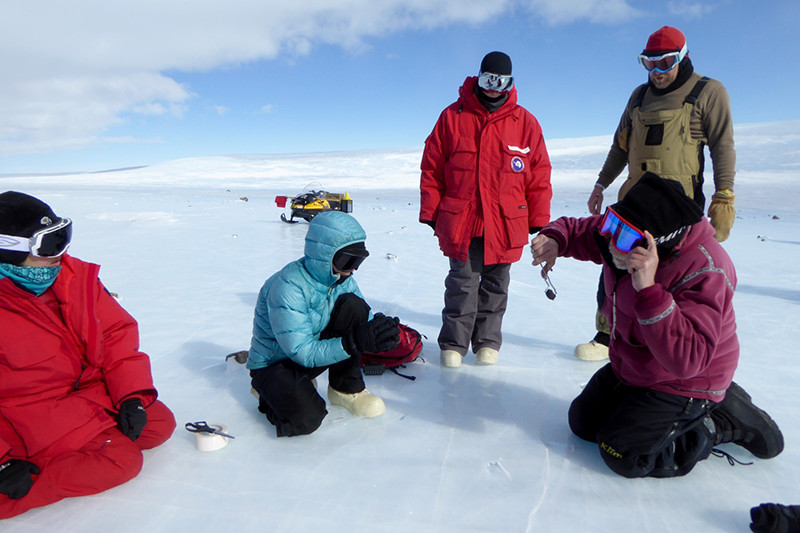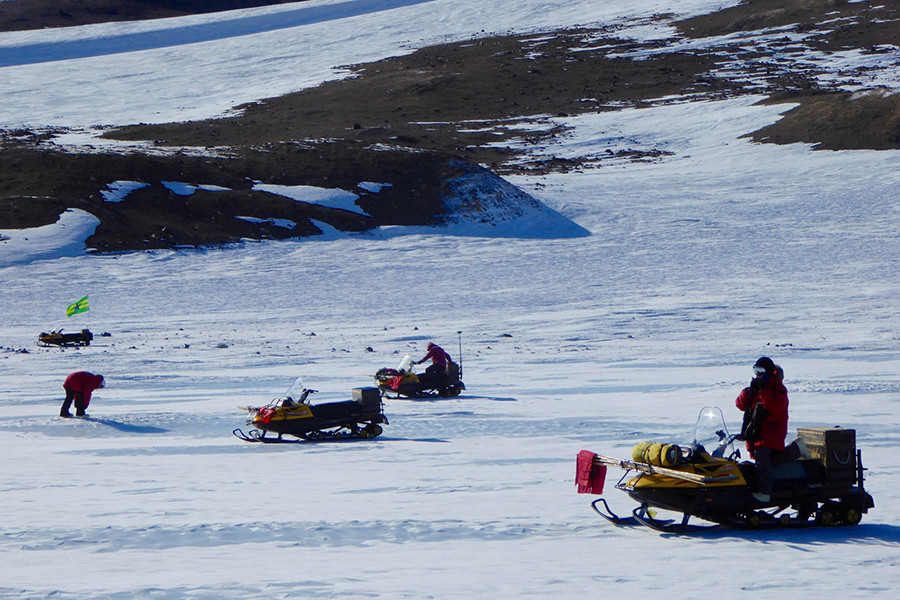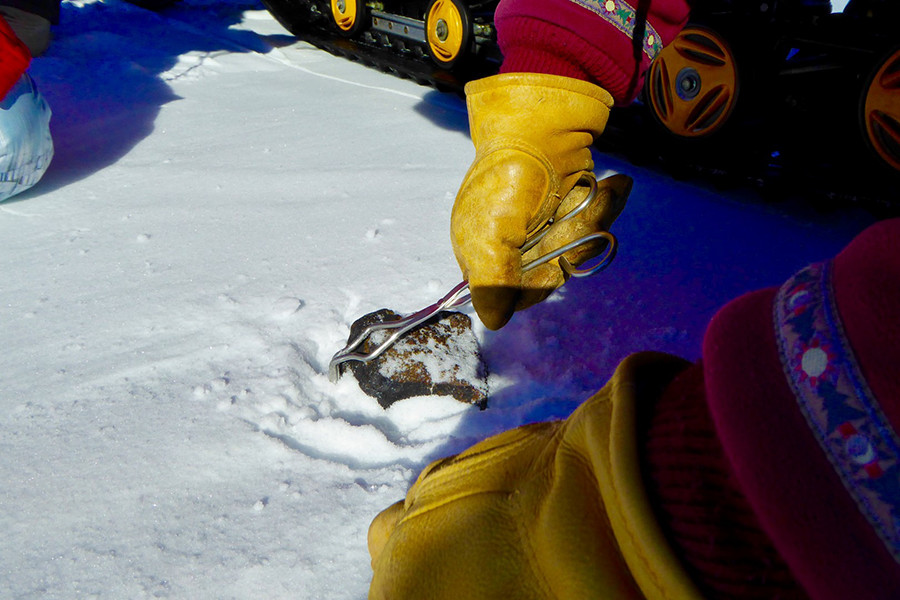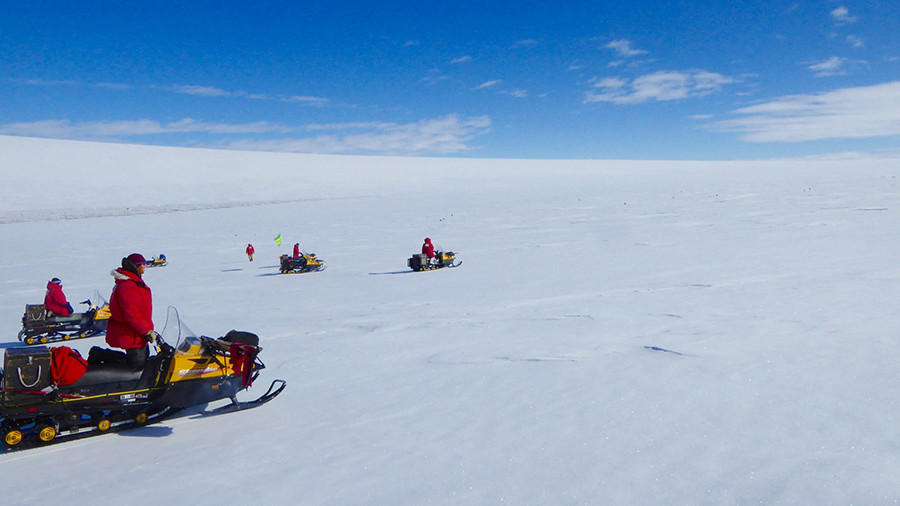
Photo Credit: Constantine Tsang
|
The ANSMET team looks on as mountaineer John Schutt uses sterilized tongs to pick up and take a careful
look at a meteorite before bagging it for later study.
|
Little Pieces of Outer Space on the Frozen Continent
How scientists recover fragments of the ancient solar system at the bottom of the planet
By Michael Lucibella, Antarctic Sun Editor
Posted July 5, 2016
The Antarctic ice is home to stuff “not of this Earth.”

Photo Credit: Constantine Tsang
The team set up camp along the Transantarctic Mountains at the Miller Range, about halfway between McMurdo Station and the South Pole.
Each year, scientists travel to remote sections of the frozen continent to look for these pieces of outer space. They’re hunting for meteorites; the charred remains of asteroids and other space debris that fell to Earth. This year, after five weeks out in the field, the eight-person Antarctic Search for Meteorites (ANSMET) team returned with 569 likely meteorites.
“That’s a good haul,” said James Karner, a scientist at Case Western Reserve University and co-principal investigator on the project. “In that bunch I think there’s the potential for about dozen or so to be really special meteorites, kind of rare ones.”
In coming months, these samples will be processed at NASA’s Johnson Space Flight Center, and made available to researchers around the world to study. The project is funded by NASA and the field work is logistically supported by the National Science Foundation (NSF), which manages the U.S. Antarctic Program.
The search for meteorites is but one of the ways in which Antarctic serves as a globally unique natural research laboratory, accessible to U.S. researchers only through the support provided by the Antarctic Program.
“What we’re trying to do is understand the formation of the solar system, and how the planets themselves formed,” said Constantine Tsang, a planetary scientist at the Southwest Research Institute. “[Meteorites] give us a direct measurement of the distant past that you could never get any other way… There’s actual material that’s been preserved in space for that amount of time.”

Photo Credit: Constantine Tsang
Their dark fusion crust makes meteorites easy to see against the white and blue ice. When they’re collected, each meteorite is carefully recorded and cataloged.
Antarctica is the ideal place on Earth for meteorite hunting. Roughly two-thirds of all meteorites available to researchers were found on the icy continent.
“You need two good things to make meteorite collection efficient and economical. One you need to lay out a big white sheet and see what falls from the sky. Of course Antarctica fits that really, really well,” said Ralph Harvey of Case Western Reserve University and the primary principal investigator for the project. “The other is you want to work in a place where the input of earthly debris, terrestrial debris, is really low and that relatively speaking, accentuates the amount of extraterrestrial stuff.”
There are numerous big, barren ice fields across the continent that fit the bill perfectly, and over the years, the teams have been systematically exploring these areas. This year, the team set up camp at the foot of the mountains in the Miller Range, a region about halfway between McMurdo Station and the South Pole.
“It’s gorgeous out there,” Karner said. “It’s just a lot of rocks and ice and when you’re out there there’s no sound or human contamination at all. It’s just us and the ice and the rocks out there.”
This was the team’s eighth visit to the area. It’s a region where geologic processes produce a hard surface of blue ice, making for ideal meteorite recovery. Ice takes on a blueish hue at the bottom of glaciers, where tremendous pressures squeeze the frozen water molecules tightly together. To see blue ice at the surface, it means that over countless years, natural processes have stripped away the younger, uppermost layers, leaving behind only the older, azure-colored layers from the base of the glacier.

Photo Credit: Constantine Tsang
Most of the team’s search is done on the back of snowmobiles.
“Along with this old ice being forced up to the surface, it brings the things that are traveling along in the ice up with it, which means rocks and meteorites,” Karner said.
In these blue ice regions, the ice surrounding ancient embedded meteorites evaporated away, leaving the meteorites on the surface, ready for recovery. The cold, dry climate of Antarctica preserves them while they’re lying out on the surface. Even while buried inside the ice, the meteorites are protected. The ice encasing stays frozen so it doesn’t react with them and affect the sample.
“The meteorites in Antarctica are some of the least terrestrially altered meteorite samples that you can get your hands on,” said Ellen Crapster-Pregont, a graduate student at Columbia University. “Antarctica is a perfect repository for these specimens, not only because it’s a desert, which limits the effects of terrestrial weathering, but also because of the ice dynamics.”
Traveling to the deep field of Antarctica may seem like a long way to collect meteorites, but compared to where the space rocks originated from, it’s hardly any distance at all. Over the years, teams have found samples from Mars, the moon, the asteroid Vesta and numerous other smaller bodies distributed throughout the solar system.

Photo Credit: Constantine Tsang
John Schutt and Morgan Martinez prepare to collect a meteorite sample while Brian Rougeaux looks on from his snowmobile.
“This is really a cost-effective way to sample throughout the solar system,” said Nina Lanza, a researcher at Los Alamos National Lab. “We’re able to sample all of these planetary bodies without leaving home. That’s a real bargain in terms of planetary science.”
There’s never been a space mission that brought back samples from the planet Mars and of the handful of meteorites that scientists identified as originating from the red planet, the vast majority were discovered as Antarctic meteorites.
“They’re the equivalent of a visit to places that we just have no hope of visiting in the short term. They’re a way of exploring our solar system by waiting at home to see what’s out there, having it delivered,” Harvey said. “That’s what meteorites do and they do it for minuscule fraction of what space missions cost.”
There are also political reasons that make Antarctic collection viable.

Photo Credit: Constantine Tsang
The team traverse across vast ice fields in search of any visible meteorites.
“It can be hard to get meteorites from some places in the world,” said Morgan Martinez, who just defended her doctorate at the University of California in San Diego before joining the team. “But because the Antarctic treaty protects Antarctica for research and not profit purposes, we’re able to collect those meteorites and the community can have access to the meteorites without having to pay for the samples themselves to an individual or to a government or something like that.”
This upcoming season will be ANSMET’s 40th field season. Each year, the eight-member team is made up of different volunteers culled from the planetary science community. It’s one of the only science projects in the Antarctic Program that takes volunteers and there are new faces each season.
“It really injects a lot of energy to have some new people every year,” Harvey said. “The other benefit of it is when we can give meteorite researchers some exposure to the objects they work on and they can understand a lot more about how they got to be the way they are.”
Though they’re looking for extra-terrestrial samples, the search itself is pretty low-tech. There are no special tools or high-tech devices that can detect space rocks from afar. The team members rely on visual cues to distinguish meteorites from any ordinary, terrestrial rocks that are lying around.
“After a while your eye gets tuned into these very subtle distinctions,” said Cynthia Evans, the manager of NASA’s Astromaterials Acquisition and Curation Office at Johnson Space Center. She’s in charge of the office that receives the samples once they’re brought to the United States, and joined the search team to get a better understanding of where the samples come from.
On wide-open sections of ice, the search is easier. These ice plains can be so big, that the only way for a rock to wind up in the middle of it is for it to have fallen from space. In areas where there are other rocks around, they look for the dark, smooth fusion crust that’s shows that a rock fell to Earth.
Previous
1
2
Next










